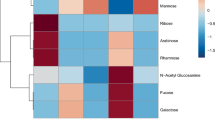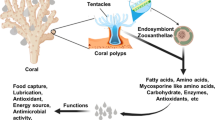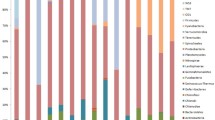Abstract
Coral mucus-degrading bacteria were isolated by an enrichment culture procedure. The isolates were able to grow as pure cultures on 10% sterilized mucus in seawater, yielding 108 CFU/ml. The isolates, mostly Vibrio strains, were classified by classical and molecular methods. When carbon, nitrogen, and phosphorus compounds were added separately to the mucus medium, there was no increase in CFUs; however, when they were added together, there was a large increase in cell yield. The indigenous bacterial population of coral mucus increased from 103 to 108 CFU/ml when incubated at 30°C for 11 h, changing from a heterogeneous community to a Vibrio-dominated population. Factors which regulate the abundance and diversity of coral mucus bacteria are discussed.




Similar content being viewed by others
References
Altschul SF, Gish W, Miller W, Myers EW, Lipman DJ (1990) Basic local alignment search tool. J Mol Biol 215:403–410
Ben-Haim Y, Banim E, Kushmaro A, Loya Y, Rosenberg E (1999) Inhibition of photosynthesis and bleaching of zooxanthellae by the coral pathogen Vibrio shiloi. Environ Microbiol 1:223–229
Ben-Haim Y, Thompson FL, Thompson CC, Cnockaert MC, Hoste B, Swings J, Rosenberg E (2003) Vibrio coralliilyticus sp nov., a temperature-dependent pathogen of the coral Pocillopora damicornis. Int J Syst Evol Microbiol 53:309–315
Brown BE, Bythell JC (2005) Perspectives on mucus secretion in reef corals. Mar Ecol Prog Ser 296:291–309
Drollett JH, Teai T, Faucon M, Martin PMV (1997) Field study of compensatory changes in UV-absorbing compounds in the mucus of the solitary coral Fungia rapanda (Scleractinia: Fungiidae) in relation to solar UV radiation, sea-water temperature, and other coincident physico-chemical parameters. Mar Freshwater Res 48:329–333
Ducklow H W, Mitchell R (1979) Bacterial-populations and adaptations in the mucus layers on living corals. Limnol Oceanogr 24:715–725
Goldberg W (2002) Feeding behavior, epidermal structure and mucus cytochemistry of the scleractinian Mycetophyllia reesi, a coral without tentacles. Tissue Cell 34:232–245
Koren O, Rosenberg E (2006) Bacteria associated with mucus and tissues of the coral Oculina patagonica in summer and winter. Appl Environ Microbiol 72:5254–5259
Koren O, Rosenberg E (2008) Bacteria associated with the bleached and cave coral Oculina patagonica. Microbial Ecol (in press)
Krupp D (1984) Mucus production by corals exposed during an extreme low tide. Pacif Sci 38:1–11
Kushmaro A, Loya Y, Fine M, Rosenberg E (1996) Bacterial infection and coral bleaching. Nature 380:396–396
Lane DJ (1991) 16S/23S rRNA sequencing. In: Stackebrant E, Goodfellow M (ed) Nucleic acid techniques in bacterial systematics. Wiley, New York, pp 115–175
Noble RT, Fuhrman JA (1998) Use of SYBR Green I for rapid epifluorescence counts of marine viruses and bacteria. Aquat Microb Ecol 14:113–118
Patton JS, Abraham S, Benson AA (1977) Lipogenesis in the intact coral Pocillopora clapitata and its isolates zooxanthellae: evidence for a light-driven carbon cycle between symbiont and host. Mar Biol 44:235–247
Paul JH, DeFlaun MF, Jeffrey WH (1986) Elevated levels of microbial activity in the coral surface microlayer. Mar Ecol Prog Ser 33:29–40
Rinkevich B (1989) The contribution of photosynthetic products to coral reproduction. Mar Biol 101:259–263
Ritchie KB, Dennis JH, McGrath T, Smith GW (1994). Bacteria associated with bleached and non-bleached areas of Montastrea annularis. Proc Symp Nat Hist Bahamas 5:75–80
Ritchie KB (2006). Regulation of microbial populations by coral surface mucus and mucus-associated bacteria. Mar Ecol Prog Ser 322:1–14
Rohwer F, Serigutan V Azam F, Knowlton N (2002) Diversity and distribution of coral-associated bacteria. Mar Ecol Prog Ser 243:1–10
Romaine S, Tambutte E, Allemand D, Gattuso JP (1997) Photosynthesis, respiration and calcification of a zooxanthellate scleractinian coral under submerged and exposed conditions. Mar Biol 129:175–182
Rublee PA, Lasker HR, Gottfried M, Roman MR (1980) Production and bacterial-colonization of mucus from the soft coral Briarium-Asbestinum. Bull Mar Sci 30:888–893
Schloss PD, Handelsman J (2005) Introducing DOTUR, a computer program for defining operational taxonomic units and estimating species richness. Appl Environ Microbiol 71:1501–1506
Schuhmacher H (1977) Ability in fungiid corals to overcome sedimentation. In: Proceedings, 3rd International Coral Reef Symposium, Miami, Florida. University of Miami, Coral Gables, pp 503–509
Shashar N, Cohen Y, Loya Y (1993). Extreme diel fluctuations of oxygen in diffusive boundary layers surrounding stony corals. Biol Bull 185:455-461
Shashar N, Cohen Y, Loya Y, Sar N (1994) Nitrogen-fixation (acetylene-reduction) in stony corals—evidence for coral-bacteria interactions. Mar Ecol Prog Ser 111:259–264
Thompson J D, Gibson TJ, Plewniak F, Jeanmougin F, Higgins DG (1997) The CLUSTAL_X windows interface: flexible strategies for multiple sequence alignment aided by quality analysis tools. Nucleic Acids Res 25:4876–4882
Wild C, Huettel M, Klueter A, Kremb SG, Rasheed MYM, Jorgensen BB (2004) Coral mucus functions as an energy carrier and particle trap in the reef ecosystem. Nature 428:66–70
Acknowledgments
This research was supported by grants from the Israel Center for the Study of Emerging Diseases, the World Bank Coral Disease and Bleaching Groups, and the Pasha Gol Chair for Applied Microbiology.
Author information
Authors and Affiliations
Corresponding author
Rights and permissions
About this article
Cite this article
Sharon, G., Rosenberg, E. Bacterial Growth on Coral Mucus. Curr Microbiol 56, 481–488 (2008). https://doi.org/10.1007/s00284-008-9100-5
Received:
Accepted:
Published:
Issue Date:
DOI: https://doi.org/10.1007/s00284-008-9100-5




